Saint Michael in the Catholic Church
Saint Michael the Archangel is referenced in the Old Testament and has been part of Christian teachings since the earliest times.[1] In Catholic writings and traditions he acts as the defender of the Church and chief opponent of Satan, and assists persons at the hour of death.
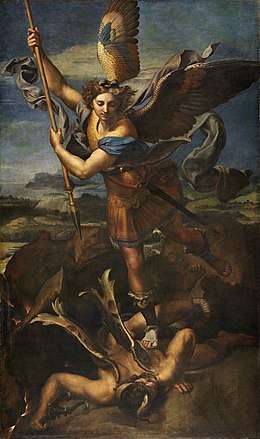
%2C_chapel_window_2%2C_Archangel_Michael%2C_detail.jpg)
A widely used "Prayer to Saint Michael" was brought into official use by Pope Leo XIII in 1886 and was recommended by Pope John Paul II in 1994. The feast day of the archangels Michael, Gabriel, and Raphael is September 29.
Prayer to Saint Michael
The Prayer to Saint Michael reads:
"Saint Michael the archangel, defend us in battle. Be our protection against the wickedness and snares of the Devil. May God rebuke him, we humbly pray, and do thou, O Prince of the Heavenly hosts, by the power of God, cast into Hell Satan, and all the evil spirits who prowl about the world, seeking the ruin of souls. Amen."[2]
Angels and archangels
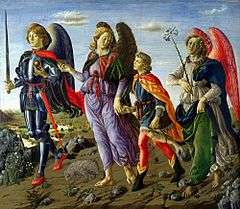
The Catechism of the Catholic Church states that: "The whole life of the church benefits from the mysterious and powerful help of the angels.... From its beginning until death, human life is surrounded by their watchful care and intercession."[3] "Christ is the center of the angelic world. They are His angels....They belong to him because they were created through and for him."[4]
Catholic tradition calls Michael, Gabriel and Raphael archangels. The word archangel comes from the Greek words arche (prince) and angelos (messenger). Michael means "Who is like God?" (a rhetorical question), Gabriel means "Power of God" or "Strong One of God" and Raphael means "God has healed".[5] Michael, Gabriel, and Raphael are named in the Bible as angels. (Roman Catholics accept as canonical the Book of Tobit, in which Raphael is named.) Only Michael is called an archangel in the Bible. The feast of these angels is celebrated on September 29.
Within the hierarchy of the angels, at the highest level, St. Michael is a princely seraph,[6] an angel of supreme power and the leader of God's army.
Christian art often portrays archangels together. Archangels Michael and Gabriel are jointly depicted on Our Lady of Perpetual Help, a Byzantine icon of the Blessed Virgin Mary that has been the subject of widespread Catholic devotions for centuries.
In scripture
Michael is mentioned by name five times in the Bible.
- Daniel 10:13, Gabriel says, "...but the prince of the kingdom of Persia stood in my way for twenty-one days, until finally Michael, one of the chief princes, came to help me."
- Daniel 10:21, "No one supports me against all these except Michael, your prince, standing as a reinforcement and a bulwark for me."
- Daniel 12:1, "At that time there shall arise Michael, the great prince, guardian of your people; It shall be a time unsurpassed in distress since nations began until that time."
- Jude 1:9, "Yet the archangel Michael, when he argued with the devil in a dispute over the body of Moses, did not venture to pronounce a reviling judgment upon him but said, 'May the Lord rebuke you!'"
- Revelation 12:7–9, "Then war broke out in heaven; Michael and his angels battled against the dragon. The dragon and its angels fought back, but they did not prevail and there was no longer any place for them in heaven. The huge dragon, the ancient serpent, who is called the Devil and Satan, who deceived the whole world, was thrown down to earth, and its angels were thrown down with it."
Role and mission

In Roman Catholicism Saint Michael has four distinct roles. First, he is the Enemy of Satan and the fallen angels. He defeated Satan and ejected him from Paradise and will achieve victory at the hour of the final battle with Satan. Secondly, he is the Christian angel of death: at the hour of death, Saint Michael descends and gives each person the chance to redeem oneself before passing. Saint Michael's third role is weighing peoples' merits (hence the saint is often depicted holding scales) on Judgment Day. And finally, Saint Michael is the Guardian of the Church.[8]
Defeat of Satan and the fallen angels
Saint Michael is viewed as the commander of the Army of God. From the time of the apostles, he has been invoked and honored as the protector of the Church. Scripture describes him as "one of the chief princes" and the leader of heaven's forces in their triumph over the powers of hell.[9]
Saint Michael defeats Satan two times, first when he ejects Satan from Paradise, and then in the final battle of the end times when the Antichrist will be defeated by him. Noted hagiographer Alban Butler, defined the role of Saint Michael: "Who is like God?" was the cry of Archangel Michael when he smote the rebel Lucifer in the conflict of the heavenly hosts. And when Antichrist shall have set up his kingdom on earth, it is St Michael who will unfurl once more the standard of the cross, sound the last trumpet, bind together the false prophet and the beast and hurl them for all eternity into the burning pool.[10]
Saint Michael is the traditional prototype of the spiritual warrior, a paradigm extended to other warrior saints. This conflict against evil may at times be viewed as an interior battle. The concept of the warrior saint has extended to other Catholic saints, beginning with examples such as Saint George and Saint Theodore of Amasea.[11]

At the hour of death
Saint Michael is one of the angels presumed present at the hour of death. Traditionally, he is charged to assist the dying and accompany them to their particular judgment, where he serves as an advocate.[12] Cemetery chapels are often dedicated to him, where Masses are offered in his honor on behalf of the departed.[13]
Weighing souls on Judgment Day
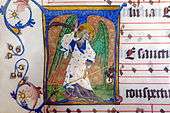
In Catholic tradition, on Judgment Day Saint Michael weighs souls based on their deeds during their life on earth. Saint Michael is often portrayed in art with scales.[14] This role of Saint Michael was depicted by Michelangelo on the ceiling of the Sistine Chapel. In this depiction, angels hold up two books: the smaller book held by Saint Michael records the names of the blessed, while the larger book is a list of the damned.[15]
Guardian of the Church
The tradition of Michael as prince-protector of the Jewish people was adopted by the Christian Church.[16] Saint Michael has long been recognized as the protector and guardian of the Church itself and the angel of the Blessed Sacrament. In a 2007 address Pope Benedict XVI urged the bishops he was ordaining to take Michael as a model in making room in the world for God, countering denials of him and thus defending humankind's greatness, and in acting as "true guardian angels" of the Church.[17] Saint Michael is also the guardian angel of the pope and has been invoked as the patron and guardian angel of many countries as well as specific professions.[18][19]
Cultus
"Of all the angels, Michael was by far the most important in the Middle Ages."[20] The earliest indications of a cult of St. Michael occur in the Near East. The emperor Constantine built the Michaelion at Chalcedon on the site of an earlier temple. Other sanctuaries were located at healing springs in Anatolia, Antioch, and Egypt. Identification of St Michael with the gift of healing can be seen in Gregory the Great leading a devotional procession in 590 when the city of Rome was afflicted with a plague that killed his predecessor. Gregory reportedly saw a vision of Saint Michael atop the Mausoleum of Hadrian. The archangel sheathed his sword, suggesting to the pope that the peril was ended. He subsequently renamed the Mausoleum Castel Sant'Angelo (Castle of the Holy Angel) in honor of St. Michael.[21][22]
The Visio Sancti Pauli, written in the late fourth or early fifth century, presents St Michael as an advocate for sinners, guarantor of rain, and thus a patron of agriculture. The Greek, Syrian, and Coptic Churches had venerated St. Michael since at least the early sixth century. The cult of St. Michael was widespread in the British Isles during the Middle Ages.[23]
Legends include a number of reported appearances of Saint Michael, where sanctuaries or churches were later built or dedicated to him. These include Monte Gargano in Italy early in the 6th century where the Sanctuary of Monte Sant'Angelo, the oldest shrine in Western Europe, is dedicated to Saint Michael. Early in the 8th century, Saint Michael reportedly appeared three times to Saint Aubert, the bishop of Avranches in Normandy, France, and instructed him to build a church on the small island now known as Mont Saint-Michel. Several healings were reported when the church was being built and Mont Saint-Michel still remains a Catholic pilgrimage site.[24][25]
The role of Saint Michael as protector and guardian has also led to the design of statues that depict him, and the construction of Churches and monasteries at specific locations. Because most monastic islands lie close to land, they were viewed as forts holding demons at a distance against attacks on the Church. Monasteries such as Mont Saint-Michel off the coast of Normandy, France, and Skellig Michael, off the coast of County Kerry, Ireland, dedicated to the Archangel are examples of these.[26] Another notable structure is that of St Michael's Mount, located in Mounts Bay, near Penzance, Cornwall – a stunning island castle that resembles Mont Saint-Michel, and can only be reached on foot at low tide.
St. Bernard of Clairvaux recommended the invocation of Saint Michael at times of temptation and sorrow: "Whenever any grievous temptation or vehement sorrow oppresses thee, invoke thy guardian, thy leader, cry out to him, and say, 'Lord, save us, lest we perish!'"[10]
St. Francis of Assisi was especially devoted to Saint Michael and would fast for about forty days from the feast of the Assumption (August 15) to Saint Michael's feast day on September 29.[27] Some Franciscan communities continue to observe the period from August 15 to September 29 as "St. Michael's Lent", a time of fasting and prayer.
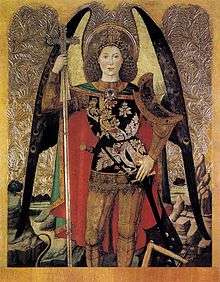
Mentions in the Tridentine liturgy
In editions of the Roman Missal before 1970, Saint Michael was mentioned in the Confiteor as recited by the priest and again in the altar server's response at Mass. He was mentioned also in celebrations of Solemn Mass when the priest put incense in the thurible, reciting the prayer: Per intercessionem beati Michaelis Archangeli, stantis a dextris altaris incensi, et omnium electorum suorum, incensum istud dignetur Dominus benedicere, et in odorem suavitatis accipere. Per Christum Dominum nostrum. Amen. (Through the intercession of Blessed Michael the Archangel, standing at the right hand of the altar of incense, and of all his elect, may the Lord kindly bless this incense and accept it as a savour of sweetness).[28]
Until Pope John XXIII revised it in 1960, the General Roman Calendar had not one but two feasts of Saint Michael, one on 29 September, the other on 8 May.[28]
Veneration
Patronage
Michael the Archangel is the patron saint of grocers, mariners, paratroopers, police officers, and military personnel.
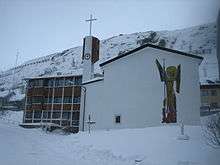
A large number of Roman Catholic churches around the globe are dedicated to Saint Michael, from Hammerfest, Norway, to Oeste Catarinense in Brazil. Saint Michael's feast day of September 29 has been solemnly celebrated in many locations since the fifth century. And many churches that honor Saint Michael are dedicated on the 29th of September, e.g., Pope Boniface IV dedicated Saint Michael's Church in Rome on that day in 610.[29]
Devotions
Devotions to Saint Michael have a large Catholic following, and a number of churches are dedicated to him worldwide. Roman Catholic devotions to Saint Michael have been expressed in a variety of forms, including a chaplet and scapular.[30] A number of prayers, novenas, and hymns are directed to him.
Prayers
Pope Leo XIII added a Prayer to Saint Michael to the Leonine Prayers in 1886.[31] Although these prayers are no longer recited after Mass, as they were until 1964, Pope John Paul II encouraged the Catholic faithful to continue to pray it, saying: "I ask everyone not to forget it and to recite it to obtain help in the battle against forces of darkness."[32] Like any other novena, the novenas to Saint Michael are prayed on nine consecutive days.
A prayer to St. Michael for protection is found in the Carmina Gadelica, collected by Alexander Carmichael in the Gaelic-speaking regions of Scotland.
O Michael of the Angels
|
From foes upon earth,
|

Chaplet
The Chaplet of Saint Michael is a chaplet attributed to a private revelation by Saint Michael to the Portuguese Carmelite nun Antónia d'Astónaco in 1751. This chaplet was approved by Pope Pius IX in 1851.[34][35]
Scapular
The Scapular of St. Michael the Archangel is a Roman Catholic devotional scapular associated with Saint Michael. Pope Pius IX gave to this scapular his blessing, but it was first formally approved under Pope Leo XIII who sanctioned the Archconfraternity of the Scapular of Saint Michael.[36]

Exorcism
A prayer to Saint Michael is included in the Rite of Exorcism in the Roman Ritual, and was retained, in edited form, in the 1999 revision of the rite. At the Benedictine Metten Abbey dedicated to Saint Michael the exorcism formula Vade Retro Satana was discovered in the 17th century.[37][38]
Hymns
Through the centuries, Catholic devotions to Saint Michael have resulted in a number of poems and hymns. [39][40][41]
An example is the "Hymn to Archangel Michael":
O angel! Bear, O Michael of great miracles, To the Lord my plaint.
Hearest thou? Ask of forgiving God Forgiveness of all my vast evil.
Delay not! Carry my fervent prayer To the King, the great King!
To my soul Bring help, bring comfort At the hour of its leaving earth.
Stoutly To meet my expectant soul Come with many thousand angels!
O Soldier! Against the crooked, wicked, militant world Come to my help in earnest!
Do not Disdain what I say! As long as I live do not desert me!
Thee I choose, That thou mayst save my soul, My mind, my sense, my body.
O thou of goodly counsels, Victorious, triumphant one, Angelic slayer of Antichrist!
The hymn "Te Splendor" to Saint Michael (which derives its name from the fact that in Latin it begins with Te splendor et virtus Patris) is published in the Raccolta collection of prayers with indulgences.[42]
Art and architecture
Paintings
| Wikimedia Commons has media related to Archangel Michael structured art gallery. |
Saint Michael symbolizes the victory of good over evil, and he has been widely represented in art through the ages. Depictions of Saint Michael often portray the scene where Satan, or the fallen angels, are helpless below the sword or spear of a triumphant Saint Michael.[43] In some depictions, the Latin phrase Quis ut Deus? can be seen on the shield of Saint Michael. The phrase means "Who is like God?" and Saint Michael asks it scornfully as he slays Satan, represented as a dragon, or a man-like figure, at times with wings.[21][44]
The original meaning of the name Michael gave rise to the Latin phrase Quis ut Deus? which can be seen on his artistic portrayals of Michael defeating Satan.[36]
 The triumphant St. Michael, by Dosso Dossi, 16th century
The triumphant St. Michael, by Dosso Dossi, 16th century St. Michael and fallen angels Rubens, 17th century
St. Michael and fallen angels Rubens, 17th century St. Michael in victory, Bartolomé Esteban Murillo, 17th century
St. Michael in victory, Bartolomé Esteban Murillo, 17th century Johann M. Rottmayr, St. Michael's Triumph, 1697
Johann M. Rottmayr, St. Michael's Triumph, 1697
 St. Michael by Guariento, 14th century
St. Michael by Guariento, 14th century- St Michael weighing souls during the Last Judgement, 16th century, Cologne
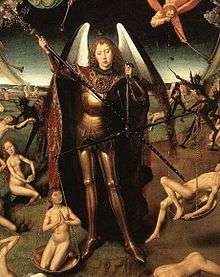 St. Michael weighing souls on Judgement Day by Hans Memling, 15th century
St. Michael weighing souls on Judgement Day by Hans Memling, 15th century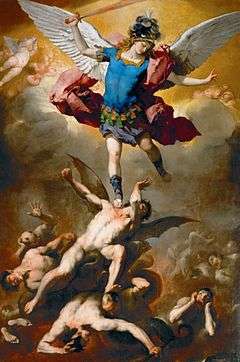 Archangel Michael and fallen angels, Luca Giordano c. 1660–65
Archangel Michael and fallen angels, Luca Giordano c. 1660–65
Icons
- For a larger gallery of icons, please see: Saint Michael icons gallery.
 13th century icon, Saint Catherine's Monastery
13th century icon, Saint Catherine's Monastery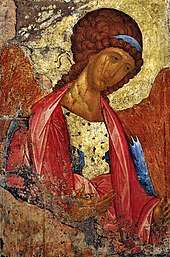 Russian icon by Andrei Rublev, c. 1408
Russian icon by Andrei Rublev, c. 1408 Michael the Archangel and biblical scenes, Russian icon, c. 1410
Michael the Archangel and biblical scenes, Russian icon, c. 1410- Archangel Michael in Victory, by Simon Ushakov, 1676
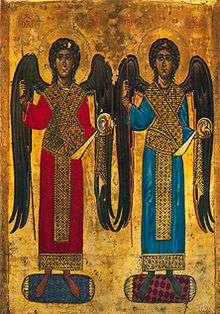 Archangels Michael and Gabriel, 12th century, Saint Catherine's Monastery
Archangels Michael and Gabriel, 12th century, Saint Catherine's Monastery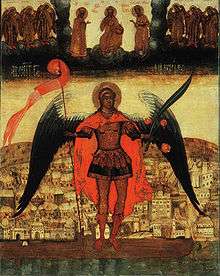 City of Archangel Michael with other angels and saints, Russian icon, 1741
City of Archangel Michael with other angels and saints, Russian icon, 1741- Russian icon of the Seven Archangels including Michael, 19th century
 Gathering of the 7 Holy Archangels, early 20th-century Russian icon
Gathering of the 7 Holy Archangels, early 20th-century Russian icon
Statues
- For a larger gallery of paintings and statues, please see: Saint Michael statues gallery.
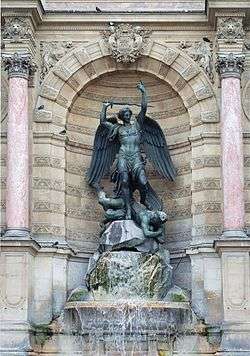 St Michael's Fountain, on Boulevard Saint-Michel, Paris
St Michael's Fountain, on Boulevard Saint-Michel, Paris At Castel Sant'Angelo, Rome, 1753
At Castel Sant'Angelo, Rome, 1753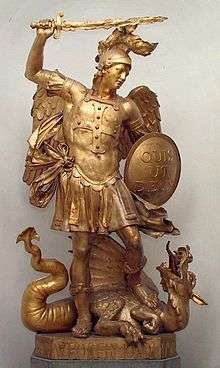 University of Bonn, Germany
University of Bonn, Germany Hamburg, Germany
Hamburg, Germany
Churches
- Lists of churches dedicated to Saint Michael are given on the disambiguation pages: St. Michael's Church and Cathedral of Saint Michael.
- For a larger gallery of church images, please see: Saint Michael church gallery.
 Sanctuary of St. Michael the Archangel, Mount Sant'Angelo, Italy
Sanctuary of St. Michael the Archangel, Mount Sant'Angelo, Italy Mont Saint Michel Abbey, Mount Saint Michael, France
Mont Saint Michel Abbey, Mount Saint Michael, France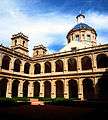 San Miguel de Los Reyes Monastery, Valencia, Spain
San Miguel de Los Reyes Monastery, Valencia, Spain.jpg) St. Michael's Cathedral, Toronto
St. Michael's Cathedral, Toronto Sacra di San Michele, c. 1000 Piedmont, Italy
Sacra di San Michele, c. 1000 Piedmont, Italy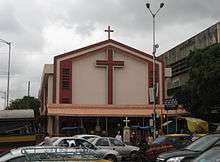 St. Michael's Church, Mumbai, India
St. Michael's Church, Mumbai, India- San Miguel church, Temascalcingo, Mexico


Altars
_02.jpg) St. Michael's Basilica, Madrid, Spain
St. Michael's Basilica, Madrid, Spain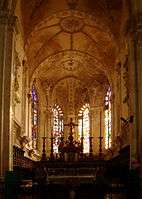 Saint Michel Church, Saint-Mihiel, Lorraine, France
Saint Michel Church, Saint-Mihiel, Lorraine, France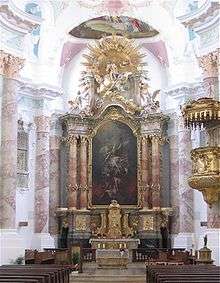 St. Michael in Berg am Laim, Munich, Germany
St. Michael in Berg am Laim, Munich, Germany
See also
- Michaelmas
- Scapular of St. Michael the Archangel
- Prayer to Saint Michael
- Novena to Saint Michael
References
- Kelly, John Norman. Early Christian Doctrines Continuum Publishing, 2000 ISBN 0-8264-5252-3 p. 7
- "EWTN Global Catholic Television Network: Catholic News, TV, Radio | EWTN". EWTN Global Catholic Television Network. Retrieved 2020-07-08.
- Catechism of the Catholic Church David Bordwell, the Vatican, Continuum International Publishing, 2002 ISBN 0-86012-324-3, p.78, §§334–335
- Catechism of the Catholic Church §331.
- Ball, Anne. Encyclopedia of Catholic Devotions and Practices OSV Press 2003, ISBN 0-87973-910-X p.42
- Stravinskas, Peter M. J., OSV's Catholic Encyclopedia, OSV Publishing, 1998 ISBN 0-87973-669-0 page 100
- "CATHOLIC ENCYCLOPEDIA: Basilica of Saint Peter". www.newadvent.org. Retrieved 2020-01-19.
- O'Boyle, Donna-Marie. Catholic Saints Prayer Book OSV Publishing, 2008 ISBN 1-59276-285-9 p.61
- O'Boyle, p.60.
- Butler, Alban. Lives of the Saints, Forgotten Books ISBN 1-60506-312-6 p.372
- Starr, Mirabai. Saint Michael: The Archangel, Published by Sounds True, 2007 ISBN 1-59179-627-X p.2
- Johnson 2005, p.30.
- Ball, pp.42, 425.
- Mornin, Edward. Saints: A Visual Guide, Frances Lincoln. 2006 ISBN 0-7112-2606-7 p.18
- "Sistine Chapel", Vatican Archived 2010-05-26 at the Wayback Machine
- Johnson, Richard Freeman. Saint Michael the Archangel in Medieval English Legend, Boydell Press, 2005 ISBN 9781843831280
- "29 September 2007: Holy Mass with Episcopal Ordinations | BENEDICT XVI". www.vatican.va. Retrieved 2020-01-19.
- Butler, Alban. The lives of the fathers, martyrs, and other principal saints, B. Dornin, 1821, p.117
- McGrath, Michael. Patrons and Protectors, Liturgy Training, 2001, ISBN 1-56854-109-0
- Keck, David. Angels and Angelology in the Middle Ages, Oxford University Press, Jul 23, 1998 ISBN 9780195354966
- "CATHOLIC ENCYCLOPEDIA: St. Michael the Archangel". www.newadvent.org. Retrieved 2020-01-19.
- William Connell, Society and individual in Renaissance University of California Press, 2002 ISBN 0-520-23254-2 page 418
- Johnson, Richard Freeman. The Cult of Saint Michael the Archangel in Anglo-Saxon England, Northwestern University, 1998
- Johnson 2005, p.42.
- Walsham, Alexandra. Angels in the early modern world, Cambridge University Press, 2006 ISBN 0-521-84332-4 page 2008
- Johnston, William M., Encyclopedia of Monasticism, Taylor & Francis, 2000, ISBN 1-57958-090-4, p.672
- Armstrong, Regis. Francis of Assisi: early documents New City Press, 2000 ISBN 1-56548-112-7 p.374
- "Sancta Missa - Missale Romanum (Roman Missal) in PDF Format". sanctamissa.org. Retrieved 2020-01-19.
- Butler, Alban. The lives of the fathers, martyrs, and other principal saints, J. Duffy, 1866 p.320
- "CATHOLIC ENCYCLOPEDIA: Scapular". www.newadvent.org. Retrieved 2020-01-19.
- Irish Ecclesiastical Review 7 (1886), 1050
- John Paul II, Regina Coeli address 24 April 1994.
- Carmichael, Alexander. Carmina Gadelica, p.149, Oliver and Boyd, Edinburgh, 1940
- Ann Ball, 2003 Encyclopedia of Catholic Devotions and Practices ISBN 0-87973-910-X page 123
- EWTN The Chaplet of St. Michael the Archangel
- Ball, p.520.
- Michael Kunzler, The Church's Liturgy, Published by LIT Verlag 2001 ISBN 3-8258-4854-X page 317
- Order of St. Benedict
- George Wither, The hymns and songs of the church Published by J. R. Smith, 1856, page 248
- John Henry Newman, Hymns 2008 ISBN 1-4097-1628-7 page 186
- Kuno Meyer, Selections from Ancient Irish Poetry 2007 ISBN 1-4086-3323-X page 41
- The Raccolta Collection of indulgenced prayers by T. Galli, authorized translation by Ambrose Saint John, Published by Burns and Lambert, London, 1857, page 252.
- Solrunn Nes, The mystical language of icons, Eerdmans Publishing, 2005 ISBN 0-8028-2916-3, p.91
- Elven, John. 1854, The book of family crests Henry Washbourne Publisher, p. 112
Sources
- Ball, Anne. Encyclopedia of Catholic Devotions and Practices OSV Press 2003, ISBN 0-87973-910-X
- Johnson, Richard Freeman. Saint Michael the Archangel in Medieval English Legend, Boydell Press, 2005 ISBN 9781843831280
- O'Boyle, Donna-Marie. Catholic Saints Prayer Book OSV Publishing, 2008 ISBN 1-59276-285-9
